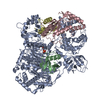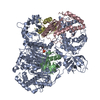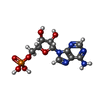[English] 日本語
 Yorodumi
Yorodumi- PDB-8se9: Cryo-EM structure of a double loaded human UBA7-UBE2L6-ISG15 thio... -
+ Open data
Open data
- Basic information
Basic information
| Entry | Database: PDB / ID: 8se9 | |||||||||||||||||||||||||||||||||||||||||||||
|---|---|---|---|---|---|---|---|---|---|---|---|---|---|---|---|---|---|---|---|---|---|---|---|---|---|---|---|---|---|---|---|---|---|---|---|---|---|---|---|---|---|---|---|---|---|---|
| Title | Cryo-EM structure of a double loaded human UBA7-UBE2L6-ISG15 thioester mimetic complex (Form 2) | |||||||||||||||||||||||||||||||||||||||||||||
 Components Components |
| |||||||||||||||||||||||||||||||||||||||||||||
 Keywords Keywords | LIGASE / Signaling Protein | |||||||||||||||||||||||||||||||||||||||||||||
| Function / homology |  Function and homology information Function and homology informationISG15 activating enzyme activity / ISG15 transferase activity / Ligases; Forming carbon-sulfur bonds; Acid-thiol ligases / ISG15-protein conjugation / positive regulation of protein oligomerization / regulation of type II interferon production / protein localization to mitochondrion / NS1 Mediated Effects on Host Pathways / response to type I interferon / Modulation of host responses by IFN-stimulated genes ...ISG15 activating enzyme activity / ISG15 transferase activity / Ligases; Forming carbon-sulfur bonds; Acid-thiol ligases / ISG15-protein conjugation / positive regulation of protein oligomerization / regulation of type II interferon production / protein localization to mitochondrion / NS1 Mediated Effects on Host Pathways / response to type I interferon / Modulation of host responses by IFN-stimulated genes / negative regulation of type I interferon-mediated signaling pathway / E2 ubiquitin-conjugating enzyme / negative regulation of viral genome replication / RSV-host interactions / ubiquitin conjugating enzyme activity / positive regulation of interleukin-10 production / positive regulation of bone mineralization / negative regulation of protein ubiquitination / positive regulation of interferon-beta production / positive regulation of erythrocyte differentiation / ubiquitin binding / integrin-mediated signaling pathway / Negative regulators of DDX58/IFIH1 signaling / Termination of translesion DNA synthesis / PKR-mediated signaling / DDX58/IFIH1-mediated induction of interferon-alpha/beta / protein modification process / modification-dependent protein catabolic process / integrin binding / ISG15 antiviral mechanism / response to virus / positive regulation of type II interferon production / protein tag activity / protein polyubiquitination / ubiquitin-protein transferase activity / Interferon alpha/beta signaling / Antigen processing: Ubiquitination & Proteasome degradation / ubiquitin-dependent protein catabolic process / defense response to virus / defense response to bacterium / protein ubiquitination / Amyloid fiber formation / innate immune response / DNA damage response / ubiquitin protein ligase binding / SARS-CoV-2 activates/modulates innate and adaptive immune responses / extracellular region / nucleoplasm / ATP binding / nucleus / cytosol / cytoplasm Similarity search - Function | |||||||||||||||||||||||||||||||||||||||||||||
| Biological species |  Homo sapiens (human) Homo sapiens (human) | |||||||||||||||||||||||||||||||||||||||||||||
| Method | ELECTRON MICROSCOPY / single particle reconstruction / cryo EM / Resolution: 3.2 Å | |||||||||||||||||||||||||||||||||||||||||||||
 Authors Authors | Afsar, M. / Jia, L. / Ruben, E.A. / Olsen, S.K. | |||||||||||||||||||||||||||||||||||||||||||||
| Funding support |  United States, 1items United States, 1items
| |||||||||||||||||||||||||||||||||||||||||||||
 Citation Citation |  Journal: Nat Commun / Year: 2023 Journal: Nat Commun / Year: 2023Title: Cryo-EM structures of Uba7 reveal the molecular basis for ISG15 activation and E1-E2 thioester transfer. Authors: Mohammad Afsar / GuanQun Liu / Lijia Jia / Eliza A Ruben / Digant Nayak / Zuberwasim Sayyad / Priscila Dos Santos Bury / Kristin E Cano / Anindita Nayak / Xiang Ru Zhao / Ankita Shukla / ...Authors: Mohammad Afsar / GuanQun Liu / Lijia Jia / Eliza A Ruben / Digant Nayak / Zuberwasim Sayyad / Priscila Dos Santos Bury / Kristin E Cano / Anindita Nayak / Xiang Ru Zhao / Ankita Shukla / Patrick Sung / Elizabeth V Wasmuth / Michaela U Gack / Shaun K Olsen /  Abstract: ISG15 plays a crucial role in the innate immune response and has been well-studied due to its antiviral activity and regulation of signal transduction, apoptosis, and autophagy. ISG15 is a ubiquitin- ...ISG15 plays a crucial role in the innate immune response and has been well-studied due to its antiviral activity and regulation of signal transduction, apoptosis, and autophagy. ISG15 is a ubiquitin-like protein that is activated by an E1 enzyme (Uba7) and transferred to a cognate E2 enzyme (UBE2L6) to form a UBE2L6-ISG15 intermediate that functions with E3 ligases that catalyze conjugation of ISG15 to target proteins. Despite its biological importance, the molecular basis by which Uba7 catalyzes ISG15 activation and transfer to UBE2L6 is unknown as there is no available structure of Uba7. Here, we present cryo-EM structures of human Uba7 in complex with UBE2L6, ISG15 adenylate, and ISG15 thioester intermediate that are poised for catalysis of Uba7-UBE2L6-ISG15 thioester transfer. Our structures reveal a unique overall architecture of the complex compared to structures from the ubiquitin conjugation pathway, particularly with respect to the location of ISG15 thioester intermediate. Our structures also illuminate the molecular basis for Uba7 activities and for its exquisite specificity for ISG15 and UBE2L6. Altogether, our structural, biochemical, and human cell-based data provide significant insights into the functions of Uba7, UBE2L6, and ISG15 in cells. | |||||||||||||||||||||||||||||||||||||||||||||
| History |
|
- Structure visualization
Structure visualization
| Structure viewer | Molecule:  Molmil Molmil Jmol/JSmol Jmol/JSmol |
|---|
- Downloads & links
Downloads & links
- Download
Download
| PDBx/mmCIF format |  8se9.cif.gz 8se9.cif.gz | 265.7 KB | Display |  PDBx/mmCIF format PDBx/mmCIF format |
|---|---|---|---|---|
| PDB format |  pdb8se9.ent.gz pdb8se9.ent.gz | 207.3 KB | Display |  PDB format PDB format |
| PDBx/mmJSON format |  8se9.json.gz 8se9.json.gz | Tree view |  PDBx/mmJSON format PDBx/mmJSON format | |
| Others |  Other downloads Other downloads |
-Validation report
| Summary document |  8se9_validation.pdf.gz 8se9_validation.pdf.gz | 1.3 MB | Display |  wwPDB validaton report wwPDB validaton report |
|---|---|---|---|---|
| Full document |  8se9_full_validation.pdf.gz 8se9_full_validation.pdf.gz | 1.3 MB | Display | |
| Data in XML |  8se9_validation.xml.gz 8se9_validation.xml.gz | 51.5 KB | Display | |
| Data in CIF |  8se9_validation.cif.gz 8se9_validation.cif.gz | 77.2 KB | Display | |
| Arichive directory |  https://data.pdbj.org/pub/pdb/validation_reports/se/8se9 https://data.pdbj.org/pub/pdb/validation_reports/se/8se9 ftp://data.pdbj.org/pub/pdb/validation_reports/se/8se9 ftp://data.pdbj.org/pub/pdb/validation_reports/se/8se9 | HTTPS FTP |
-Related structure data
| Related structure data |  40407MC  8seaC  8sebC  8sv8C  40410 M: map data used to model this data C: citing same article ( |
|---|---|
| Similar structure data | Similarity search - Function & homology  F&H Search F&H Search |
- Links
Links
- Assembly
Assembly
| Deposited unit | 
|
|---|---|
| 1 |
|
- Components
Components
| #1: Protein | Mass: 111822.102 Da / Num. of mol.: 1 Source method: isolated from a genetically manipulated source Source: (gene. exp.)  Homo sapiens (human) / Gene: UBA7, UBE1L, UBE2 / Production host: Homo sapiens (human) / Gene: UBA7, UBE1L, UBE2 / Production host:  Trichoplusia ni (cabbage looper) / References: UniProt: P41226 Trichoplusia ni (cabbage looper) / References: UniProt: P41226 | ||||||||
|---|---|---|---|---|---|---|---|---|---|
| #2: Protein | Mass: 17163.701 Da / Num. of mol.: 2 / Mutation: C78S Source method: isolated from a genetically manipulated source Source: (gene. exp.)  Homo sapiens (human) / Gene: ISG15, G1P2, UCRP / Production host: Homo sapiens (human) / Gene: ISG15, G1P2, UCRP / Production host:  #3: Protein | | Mass: 17643.377 Da / Num. of mol.: 1 / Mutation: C98S,C102S,L121K Source method: isolated from a genetically manipulated source Source: (gene. exp.)  Homo sapiens (human) / Gene: UBE2L6, UBCH8 / Production host: Homo sapiens (human) / Gene: UBE2L6, UBCH8 / Production host:  References: UniProt: O14933, E2 ubiquitin-conjugating enzyme #4: Chemical | ChemComp-AMP / | Has ligand of interest | Y | Has protein modification | Y | |
-Experimental details
-Experiment
| Experiment | Method: ELECTRON MICROSCOPY |
|---|---|
| EM experiment | Aggregation state: PARTICLE / 3D reconstruction method: single particle reconstruction |
- Sample preparation
Sample preparation
| Component | Name: Cryo-EM structure of a double loaded human UBA7-UBE2L6-ISG15 thioester mimetic complex (Form 2) Type: COMPLEX / Entity ID: #1-#3 / Source: MULTIPLE SOURCES |
|---|---|
| Molecular weight | Value: 0.160 MDa / Experimental value: YES |
| Source (natural) | Organism:  Homo sapiens (human) Homo sapiens (human) |
| Source (recombinant) | Organism:  |
| Buffer solution | pH: 7.5 |
| Specimen | Embedding applied: NO / Shadowing applied: NO / Staining applied: NO / Vitrification applied: YES |
| Vitrification | Cryogen name: ETHANE |
- Electron microscopy imaging
Electron microscopy imaging
| Experimental equipment |  Model: Titan Krios / Image courtesy: FEI Company |
|---|---|
| Microscopy | Model: FEI TITAN KRIOS |
| Electron gun | Electron source:  FIELD EMISSION GUN / Accelerating voltage: 300 kV / Illumination mode: FLOOD BEAM FIELD EMISSION GUN / Accelerating voltage: 300 kV / Illumination mode: FLOOD BEAM |
| Electron lens | Mode: BRIGHT FIELD / Nominal defocus max: 2888 nm / Nominal defocus min: 100 nm |
| Image recording | Electron dose: 80 e/Å2 / Film or detector model: GATAN K3 (6k x 4k) |
- Processing
Processing
| Software | Name: PHENIX / Version: 1.20.1_4487: / Classification: refinement | ||||||||||||||||||||||||
|---|---|---|---|---|---|---|---|---|---|---|---|---|---|---|---|---|---|---|---|---|---|---|---|---|---|
| EM software | Name: PHENIX / Category: model refinement | ||||||||||||||||||||||||
| CTF correction | Type: PHASE FLIPPING AND AMPLITUDE CORRECTION | ||||||||||||||||||||||||
| 3D reconstruction | Resolution: 3.2 Å / Resolution method: FSC 0.143 CUT-OFF / Num. of particles: 149051 / Symmetry type: POINT | ||||||||||||||||||||||||
| Refine LS restraints |
|
 Movie
Movie Controller
Controller






 PDBj
PDBj











